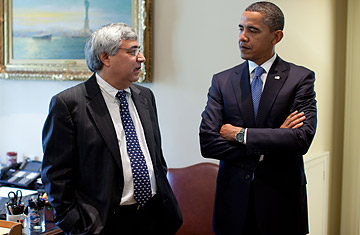
President Barack Obama talks with interim chief of staff Pete Rouse at the White House, Oct. 5, 2010
It is time for a new White House plan. Even the best case for Democrats in the midterms will leave President Barack Obama with the tarnish of repudiation and far fewer members of his own party with whom to work.
If he wants to continue to achieve his campaign promises, the President is going to have to make some profound changes, something Obama's stay-the-course history suggests does not come naturally to him.
By luck or design, however, the newly installed interim chief of staff, Pete Rouse, is one of Washington's great long-range planners. And Obama and Rouse have at least one comeback model. The Clinton game plan circa 1994 shows how a young Democratic President, seen as overreaching and lurching leftward two years into his term, can move back to the political center, reconnect with the opposition, reclaim his momentum and successfully maintain his agenda. Perusing that playbook, here are five elements Obama can borrow:
Make Some Personnel Changes
Even before the midterms, Clinton brought in David Gergen as a senior adviser and Leon Panetta as chief of staff, and then added Mike McCurry as press secretary. For his re-election, Clinton hired Mark Penn and Dick Morris. All provided symbolic and substantive bridges to Republicans and the center of the electorate. Obama might consider tapping Ken Duberstein as his chief of staff. The very able Duberstein, who served Ronald Reagan in that role, publicly declared his support for Obama before the 2008 election and would instantly give the Administration a refreshing communication channel with Republicans on Capitol Hill.
Unite with the GOP on Common Causes
Clinton knew that Republicans were so eager to pass welfare reform and deficit reduction that he could work with them on those issues and still achieve his own goals, albeit with some compromise. Obama has ready-made areas that appeal urgently to both parties: education, trade, Afghanistan and deficit reduction. If Obama can succeed in building bipartisan coalitions (and trust) in those areas, he can move on to immigration and energy.
Embrace Deficit Reduction to Reach Out
Obama, like Clinton, really does believe in the importance of bringing government spending under control. He has done a poor job of conveying that to the Tea Party adherents and other Americans who want to see the debt and deficit reduced. Obama could borrow Clinton's rhetoric, call Republicans' bluff on the issue and re-establish his fiscal bona fides with the electorate.
Confront Republicans When They Overreach
Even as Clinton maneuvered to form alliances with the GOP, he stood up to them on principle when he disagreed with their views and took political advantage of their miscalculations. The easiest way for Obama to recapture the center and push the opposition rightward is to pick some battles with conservatives — and win them.
Stand Up to His Own Party When It Is Too Liberal
Obama has on occasion talked about the importance of parental discipline of children and has criticized the teachers' unions, in effect taking on liberal dogma. There's no doubt that he believes those things in his heart. After the election, he could go a step further — as Clinton did on issues like TV violence — and challenge the connection between his party and old policies that were too permissive.
Most analysts think that, because of the weakness of the Republican 2012 presidential field and an anticipated decline in the unemployment rate, Obama is likely to be re-elected. Such conventional wisdom may be overstated: his chances of having a productive next two years and winning a second term are dependent on him launching a new plan of action next month — and overcoming his reluctance to change. And, as Obama himself demonstrated in 2008, change is the key to victory.
One Nation, Halperin's politics column for TIME.com, appears every Monday.
